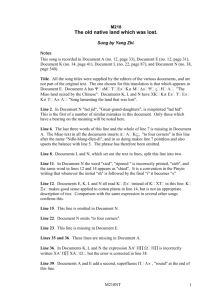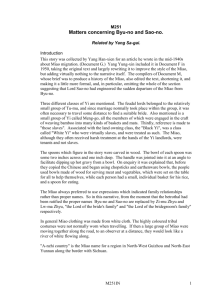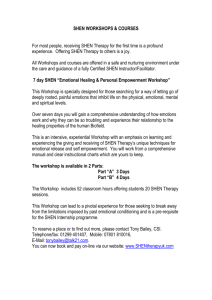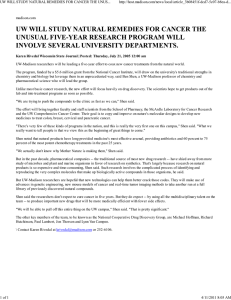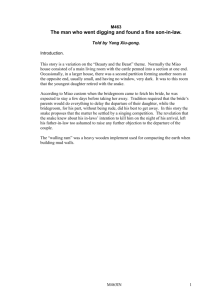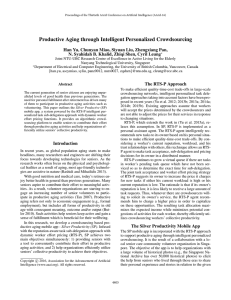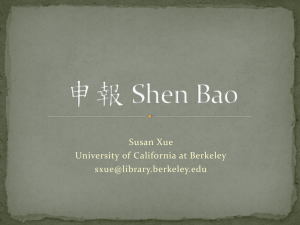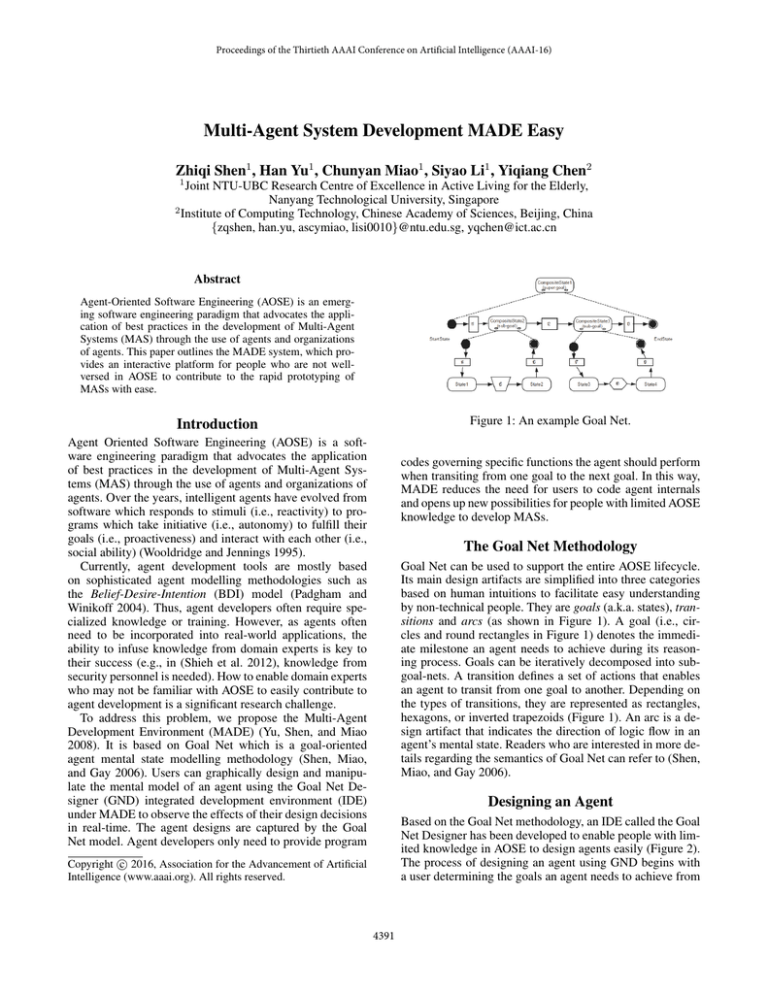
Proceedings of the Thirtieth AAAI Conference on Artificial Intelligence (AAAI-16)
Multi-Agent System Development MADE Easy
Zhiqi Shen1 , Han Yu1 , Chunyan Miao1 , Siyao Li1 , Yiqiang Chen2
1
Joint NTU-UBC Research Centre of Excellence in Active Living for the Elderly,
Nanyang Technological University, Singapore
2
Institute of Computing Technology, Chinese Academy of Sciences, Beijing, China
{zqshen, han.yu, ascymiao, lisi0010}@ntu.edu.sg, yqchen@ict.ac.cn
Abstract
Agent-Oriented Software Engineering (AOSE) is an emerging software engineering paradigm that advocates the application of best practices in the development of Multi-Agent
Systems (MAS) through the use of agents and organizations
of agents. This paper outlines the MADE system, which provides an interactive platform for people who are not wellversed in AOSE to contribute to the rapid prototyping of
MASs with ease.
Figure 1: An example Goal Net.
Introduction
Agent Oriented Software Engineering (AOSE) is a software engineering paradigm that advocates the application
of best practices in the development of Multi-Agent Systems (MAS) through the use of agents and organizations of
agents. Over the years, intelligent agents have evolved from
software which responds to stimuli (i.e., reactivity) to programs which take initiative (i.e., autonomy) to fulfill their
goals (i.e., proactiveness) and interact with each other (i.e.,
social ability) (Wooldridge and Jennings 1995).
Currently, agent development tools are mostly based
on sophisticated agent modelling methodologies such as
the Belief-Desire-Intention (BDI) model (Padgham and
Winikoff 2004). Thus, agent developers often require specialized knowledge or training. However, as agents often
need to be incorporated into real-world applications, the
ability to infuse knowledge from domain experts is key to
their success (e.g., in (Shieh et al. 2012), knowledge from
security personnel is needed). How to enable domain experts
who may not be familiar with AOSE to easily contribute to
agent development is a significant research challenge.
To address this problem, we propose the Multi-Agent
Development Environment (MADE) (Yu, Shen, and Miao
2008). It is based on Goal Net which is a goal-oriented
agent mental state modelling methodology (Shen, Miao,
and Gay 2006). Users can graphically design and manipulate the mental model of an agent using the Goal Net Designer (GND) integrated development environment (IDE)
under MADE to observe the effects of their design decisions
in real-time. The agent designs are captured by the Goal
Net model. Agent developers only need to provide program
codes governing specific functions the agent should perform
when transiting from one goal to the next goal. In this way,
MADE reduces the need for users to code agent internals
and opens up new possibilities for people with limited AOSE
knowledge to develop MASs.
The Goal Net Methodology
Goal Net can be used to support the entire AOSE lifecycle.
Its main design artifacts are simplified into three categories
based on human intuitions to facilitate easy understanding
by non-technical people. They are goals (a.k.a. states), transitions and arcs (as shown in Figure 1). A goal (i.e., circles and round rectangles in Figure 1) denotes the immediate milestone an agent needs to achieve during its reasoning process. Goals can be iteratively decomposed into subgoal-nets. A transition defines a set of actions that enables
an agent to transit from one goal to another. Depending on
the types of transitions, they are represented as rectangles,
hexagons, or inverted trapezoids (Figure 1). An arc is a design artifact that indicates the direction of logic flow in an
agent’s mental state. Readers who are interested in more details regarding the semantics of Goal Net can refer to (Shen,
Miao, and Gay 2006).
Designing an Agent
Based on the Goal Net methodology, an IDE called the Goal
Net Designer has been developed to enable people with limited knowledge in AOSE to design agents easily (Figure 2).
The process of designing an agent using GND begins with
a user determining the goals an agent needs to achieve from
c 2016, Association for the Advancement of Artificial
Copyright Intelligence (www.aaai.org). All rights reserved.
4391
the related meta-data are saved into a database on the Cloud.
To deploy an agent, the Agent Creator creates an agent based
on selected the Goal Net data. The Interpreter of the agent
parses the Goal Net data with input from the target application to decide the next goal to pursue and invokes the
tasks defined in the transition towards the next goal. The
Agent Runtime Manager supports the agent runtime environment, and facilitating the communication between agents
and the target applications. Examples of Goal Net agents
developed using MADE can be found in (Yu et al. 2010;
2011; Wu et al. 2013; Cai et al. 2014; Yu et al. 2014;
Lin et al. 2015). In summary, MADE enables agent developers to design agents graphically and develop the required
tasks in the transitions via traditional software engineering.
Figure 2: The Goal Net Designer (GND) user interface.
End-User Development
Environment
Goal Net Designer
Goal Net
Database
This research is supported, in part, by the National Research
Foundation, Prime Minister’s Office, Singapore under its
IDM Futures Funding Initiative and administered by the Interactive and Digital Media Programme Office; and the Lee
Kuan Yew Post-Doctoral Fellowship Grant.
Agent Creator
Goal Net Model Checker
Agent
Developer
Acknowledgements
Goal Net Interpreter
Task Designer
Agent Runtime
Manager
Agent
References
The target application
Cai, Y.; Shen, Z.; Liu, S.; Yu, H.; Han, X.; Ji, J.; McKeown,
M. J.; Leung, C.; and Miao, C. 2014. An agent-based game for
the predictive diagnosis of parkinson’s disease. In AAMAS’14,
1663–1664.
Lin, J.; Yu, H.; Miao, C.; and Shen, Z. 2015. An affective agent
for studying composite emotions. In AAMAS’15, 1947–1948.
Padgham, L., and Winikoff, M. 2004. Developing Intelligent
Agent Systems: A Practical Guide. John Wiley and Sons.
Shen, Z.; Miao, C.; and Gay, R. 2006. Goal-oriented methodology for agent-oriented software engineering. IEICE Transactions on Information and Systems E89(D):1413–1420.
Shieh, E.; An, B.; Yang, R.; Tambe, M.; Baldwin, C.; DiRenzo,
J.; Maule, B.; and Meyer, G. 2012. PROTECT: A deployed
game theoretic system to protect the ports of the united states.
In AAMAS’12, 13–20.
Wooldridge, M., and Jennings, N. R. 1995. Intelligent agents:
Theory and practice. The Knowledge Engineering Review
10(37).
Wu, Q.; Han, X.; Yu, H.; Shen, Z.; and Miao, C. 2013. The
innovative application of learning companions in virtual singapura. In AAMAS’13, 1171–1172.
Yu, H.; Cai, Y.; Shen, Z.; Tao, X.; and Miao, C. 2010. Agents
as intelligent user interfaces for the net generation. In IUI’10,
429–430.
Yu, H.; Shen, Z.; Miao, C.; and Tan, A.-H. 2011. A simple
curious agent to help people be curious. In AAMAS’11, 1159–
1160.
Yu, H.; Miao, C.; An, B.; Shen, Z.; and Leung, C. 2014.
Reputation-aware task allocation for human trustees. In AAMAS’14, 357–364.
Yu, H.; Shen, Z.; and Miao, C. 2008. A goal-oriented development tool to automate the incorporation of intelligent agents
into interactive digital media applications. ACM Computers in
Entertainment 6(2):24:1–24:15.
Figure 3: The MADE architecture.
the beginning to the end of a cycle of operation. This step
can be easily performed by placing the goals on the IDE interface and labeling them with proper names.
Secondly, variables in each goal can be specified using
the IDE to link them with variables in a target system in
which the agent will operate. The desirable values for the
variables which cause a goal to be regarded as achieved are
also required when the user specifies these variables.
Thirdly, the user needs to place transitions between pairs
of goals so that the agent knows what tasks need to be carried
out in order to transit from one goal to another. Within each
transition, the user can specify a list of tasks to be executed
in the given sequence. Each task can be implemented as a
web service or a function in a dynamic linked library (DLL)
so that it can be executed by the agent at runtime.
Lastly, the user connects the goals and transitions of the
goal net together using arcs. GND supports both sequential
arcs and concurrent arcs (Figure 2). In this way, complex
flows of logic represented by a combination of execution sequences can be specified for an agent.
At any stage during the design process, the user can click
on the model checking button on the GND IDE to check the
correctness of the design. The model checking function automatically checks the design for compliance with the Goal
Net semantics, identifies potential deadlocks/livelocks in the
logic, and generates a report for the user.
Deploying an Agent
As shown in Figure 3, a user interacts directly with GND.
Once an agent is designed, the Goal Net structure data and
4392

